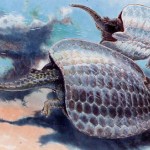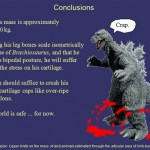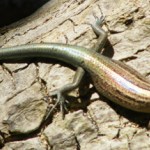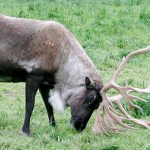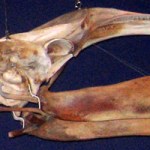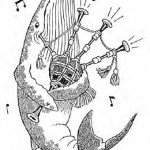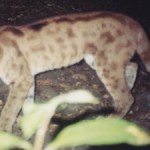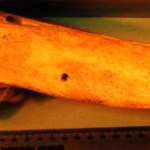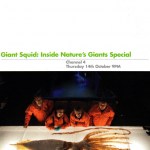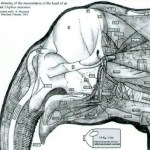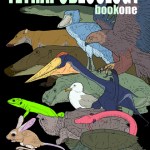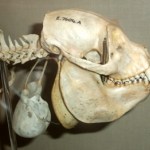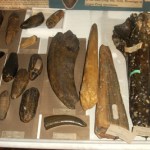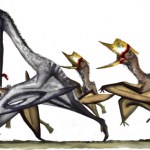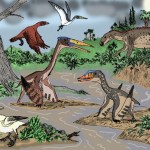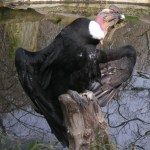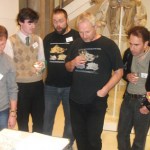
Long-time readers will know that I've been planning to cover placodonts - a group of marine, armour-plated Triassic sauropterygian reptiles - for a long, long time. Still haven't gotten round to it (though there is this one picture). But here's something, at least: a piece of text on the weird, fascinating German placodont Henodus. The text is a (slightly modified) excerpt from Naish (2004); most of the discussion on possible feeding behaviour is based on Rieppel's (2002) conclusions.
Henodus chelyops is known only from the Gipskeuper deposit of Tübingen-Lustnau (Carnian, early Upper…
The time has come to recycle this Tet Zoo classic, dating to February 2007 (it's actually one of the oldest of Tet Zoo ver 2 articles). I've updated it a bit and have included new pics - enjoy! [image below from Kaiji anatomical drawings.. read on for discussion].
To begin with, let's get things straight and admit up front that Godzilla is not a real animal, nor was it ever. It's an unfeasibly big late-surviving dinosaur (belonging to the hypothetical taxon Godzillasaurus, according to some), mutated by radiation, with a radioactive heart. Godzilla is virtually impervious to other gigantic…
There are about 3800 lizard species living on the planet today; accordingly, it can sometimes be a bit difficult to keep track of them all. Furthermore, new species are described on a very regular basis, and there's little doubt that many more species await discovery. Matty Smith (from New Zealand) recently encountered the lizard you see here while in Tonga, and he's been having trouble identifying it.
Ever one to take on a tetrapod-themed identification challenge, I had a go at identifying it, and I'd be interested in your opinion should you be able to help.
It's clearly a skink (as…
I really must get this series on pouches, sacs and pockets finished. Last time, we looked at baleen whales (and then I got distracted by Caperea): in these animals, a large, inflatable laryngeal sac is used in producing loud, resonating noises (though roles in gas storage or the mechanics of exhalation have also been suggested).
Another ventrally located laryngeal sac is present in the Reindeer Rangifer tarandus [photo above, by Karen Laubenstein, from wikipedia, shows an Alaskan reindeer with wonderfully elaborate antlers]. The sac originates from the trachea close to the epiglottis, is…
You know me, I'm not one to brag. But...
One of several interesting things I did over the weekend was attend a special cinema screening (in Clapham, London) of the giant squid special episode of Inside Nature's Giants. It was great, and the showing was followed by a Q&A session with David Dugan (ING writer/producer), presenter Mark Evans, and anatomist Joy Reidenberg. It was great to meet and chat with Joy - here's photographic proof. I gave her a copy of Tetrapod Zoology Book One*.
* Or... should that be Tetrapood Zoology Book One? The publishers are aware of the mistake and will be…
Given that we're all enjoying gawping at Caperea so much, I may as well finish up and use the rest of the photos that Joy Reidenberg kindly provided. First off, here's the skull from the side.
It's really weird: that lower jaw shape is utterly unlike anything else present in baleen whales, being comparatively deep and 'heavy' in appearance, with a downward flexure near the tip (is it just me, or does this look a bit like a flamingo mandible?). In comparison, the lower jaws of rorquals, grey whales are kin are laterally bowed, beam-like bones with cylindrical cross-sections. Those of right…
The recent discussion of Caperea's skeletal morphology (Caperea = Pygmy right whale) inspired Joy Reidenberg to send these photos of a Caperea skeleton, taken in New Zealand and used here with her permission.
In this view of the whale's thoracic region (we're standing beneath the whale, looking up into its ribcage), you can see that the transverse processes (the wing-shaped structures that project from both sides of each vertebra) are proportionally huge: so big that many of them overlap. The dorsal ends of the ribs - the parts of the ribs that contact the transverse processes - look…
Time to continue in the Tet Zoo series on laryngeal diverticula (and other pouches, pockets and sacs). This time, we look at baleen whales, or mysticetes. Like the primates we looked at previously, mysticetes have enlarged laryngeal ventricles* that (mostly) meet along the ventral midline of the throat and form a single large laryngeal pouch or sac. The presence of a raphe along the sac's ventral midline seems to mark the line of fusion between the two ancestral, bilateral sacs. It's probably understandable that few of us are aware of the presence of inflatable laryngeal sacs in mysticetes…
I've never used this picture before as I assume that most interested people have seen it. But, whatever...
The animal is a Puma Puma concolor, and it was photographed in Belize in 2002 by a remote camera (the photo comes via Marcella Kelly and has featured widely on websites that cover mystery cats). The obvious interpretation is that this near-adult individual (its proportions indicate that it's not fully grown) abnormally retained the spots present during immaturity. And it's not the only spotted puma on record. There's also this one (below), featured here in a photograph from 1936 and…
The recent, brief foray into Shoebill territory made now a sensible time to use a few other Shoebill-based images I have here in the Tet Zoo archives. That, and I haven't been able to finish anything more substantive due to other commitments. We begin with a lateral view of a skull I once photographed - sorry about the crazy colours, once again my fantastic photographic skills have done me proud (this image is a scan of a piece of special paper featuring the image... I think it's called a photograph [thanks to Victor for providing modified versions]).
Note how robust the jugal is (the thick…
Once again I'm going to do the advertising thing for those fantastic Inside Nature's Giants people. Sorry that notice is so short, but I only received the relevant information today (Wednesday 13th October). Tomorrow sees the premiere screening (here in the UK, on Channel 4) of a 75 minute ING special on the giant squid.
And, yes, once again I'm breaking the 'tetrapods only' rule... for ING, however, I can make an exception. More info below the fold.
Thanks to Tom Mustill and others at Windfall Films. If you're on facebook be sure to 'like' Joy's page.
For previous Tet Zoo articles on ING,…
Welcome to the second part of the series on the various pouches, sacs and pockets present in the heads, necks and chests of mammals. Last time we looked at the laryngeal sacs of primates (and, should you encounter unfamiliar anatomical terms in the following text, be sure to check out that first article for an anatomical primer). Comparatively speaking, the structures present in primates are well known... or, at least, their existence is comparatively well known. Less well known is the suggestion that elephants possess a sort of pouch in the throat. Or... do they?
Many people have reported…
Do you remember this post, all about a birthday card I received in 2009? (go check, then come straight back here). The picture - which I like very much - is by Elizabeth Diggins of Oakwood Artists, and I'm not the only one who likes it: it was placed runner-up in BBC Wildlife Artist of the Year competition 2010. Well, here's me, with Liz and the illustration itself, at an exhibition last night...
Funnily enough, there are a few personally relevant things here. Firstly, a Shoebill also appears on the cover of Tetrapod Zoology Book One. Secondly, the model that Liz used for her drawing has…
Earlier this year (July) my children's book on Mesozoic reptiles - Dinosaurs Life Size - appeared in the shops. People seem to like it (yikes, even if some of the 'life sized' animals are scaled wrong). July also saw the publication of Dorling Kindersley's Know It All (Baines 2010): I didn't write the whole book, just the section on prehistoric animals. Today I'm pleased to announce that my third book for 2010 - Tetrapod Zoology Book One (Naish 2010) - is finally available.
Tetrapod Zoology Book One is a compilation of over 40 articles from Tet Zoo ver 1, and as such only includes articles…
I've mentioned laryngeal and tracheal anatomy a few times on Tet Zoo (see the links at the very bottom for more). Well, time to look at it again. It's (relatively) little known that a long list of mammal species possess an assortment of 'pouches', pocket-like structures and pneumatic sacs and spaces within their throats, skulls, chests, and sometimes on their palates. Some of these are air-filled, epithelium-lined structures that originate as outgrowths of the throat or windpipe, and are hence known as diverticula (singular: diverticulum) [image below shows Siamang Symphalangus syndactylus (…
This rather unassuming photo is included for all you cetophiles out there (or, should that be cetaceophiles? Whatever). These rather crappy fossils represent an assortment of odontocete fragments from the Red Crag deposits of Suffolk, England. I initially thought that I recognised the rostrum fragments (the bigger fossils over on the right) from Richard Owen's 1870 Monograph of British Fossil Cetacea of the 'Red Crag', but I was mis-remembering, as the specimens described therein are housed in the Natural History Museum in London, not the Sedgwick Museum in Cambridge (where this photo was…
It's always been clear that pterosaurs were present in the Cornet assemblage (for the background on Cornet and its archosaur fossils, you need to have read part I).
However, exactly what sort of pterosaurs are present at Cornet has been somewhat uncertain: the Late Jurassic ctenochasmatoid Cycnorhamphus, ornithocheirids and the Early Cretaceous Asian dsungaripterid Dsungaripterus were all reported from the assemblage during the 1980s (e.g., Jurcsák & Popa 1984) but, as with the birds, the remains on which these identification were based (currently housed at the Tarii Crisurilor Museum…
Among one of many interesting and perplexing Mesozoic fossil assemblages is that known from Cornet, Romania. I've been really interested in this collection of archosaur remains - currently housed at the Tarii Crisurilor Museum, Oradea - ever since I first heard about it in the 1990s, and recently I've been lucky enough to work with Gareth Dyke, Michael Benton and Erika Posmosanu in re-evaluating the more controversial of the Cornet fossils: namely, those claimed to represent a bizarre and motley assortment of Mesozoic birds and pterosaurs. Our paper on these fossils has just been published…
For no particular reason, here are some interesting raptor photos. Birds of many kinds often sit around with their wings only partially folded, partly hanging down at their sides; one reason for this is that they're sun-bathing and are using their wings to soak up heat. Among raptors, this behaviour is well known for Turkey vultures Cathartes aura in particular. But many others do it, and here's another New World vulture (cathartid), an Andean condor Vultur gryphus, doing the same thing [photo by Markus Bühler, taken at Berlin Zoo].
During cold weather, captive Andean condors are reported…
In the previous article on the 58th Symposium on Vertebrate Palaeontology and Comparative Anatomy (SVPCA), held in Cambridge, UK, I discussed some of the work that was presented on stem-tetrapods and sauropods. This time round, we look at more Mesozoic stuff - pterosaurs in particular - before getting on to Cenozoic mammals.
Steve Sweetman presented the first outing of a new miniscule maniraptoran theropod that he and I have been working on. When it gets published, nothing will ever be the same again (massive hyperbole fully intended: Steve's talk was more to do with salamanders, anurans…
